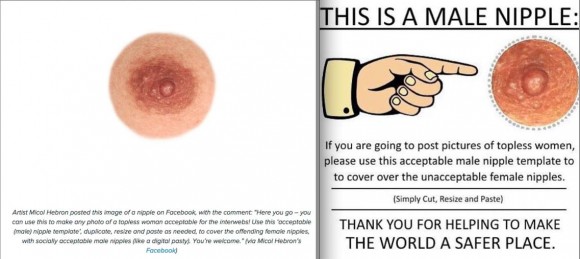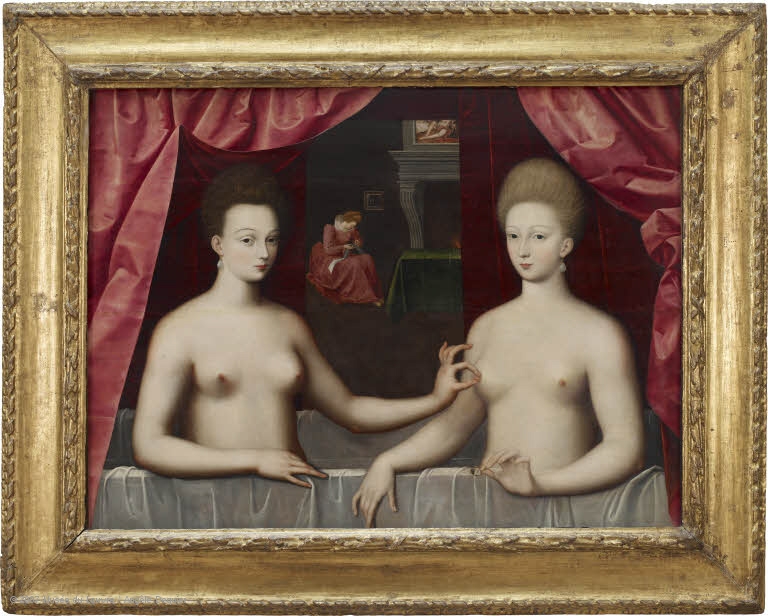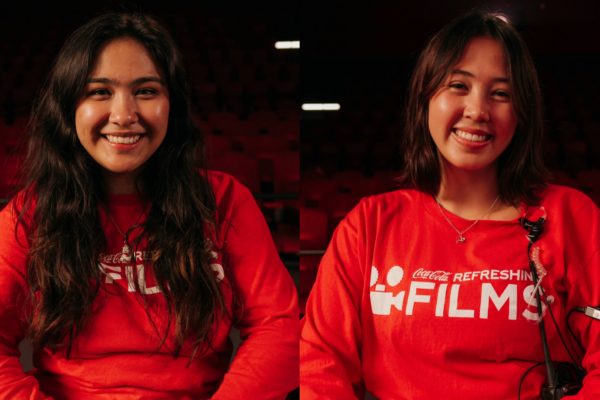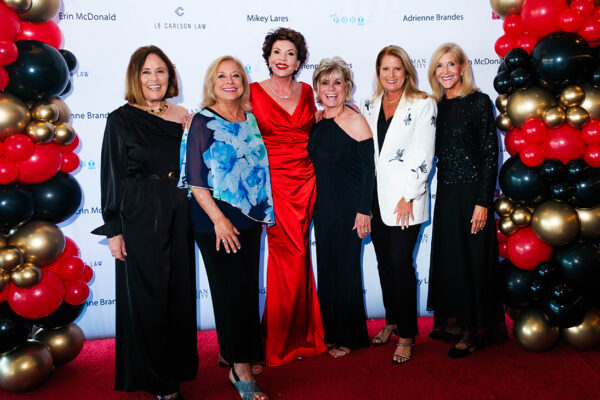The nipple has gone viral. Well, male nipples that is.
Associate professor of art
Micol Hebron
is the creator of the “Internet Acceptable Male Nipple Template,” and has been crusading for topless equality. The effort gained its viral traction earlier this summer after
Hyperallergenic.com
posted a guide to social media double standards about nipple representation, featuring Hebron’s template. That post generated 2.6 million shares. Artists Our Lady J and La Sera also shared Hebron’s template on Twitter, with more than 160,000 shares resulting. The
Huffington Post
featured Hebron and the template in a piece that received 4.5 million likes on Facebook. A
Buzzfeed
piece netted nearly 2 million shares.
Now social media is being inundated with women posting topless photos with their nipples covered by the more acceptable nipple.
But the thing is, Hebron’s not doing this to be shocking — quite the opposite. She wants a normalization of the female nipple, to make it less reactionary. She hopes society can someday be unfazed by casual, non-exploitative, non-pornographic-based bared, female breasts.
The template Hebron created features a male nipple that can be cut and pasted over a female one. It has taken over the body-politics Internet. It hasn’t come without a price — even just recently Hebron was kicked off of Facebook for a time.
We wanted to know more about the movement to normalize female nipples on the Internet and in society, so we asked Hebron five questions about her work and this project.
Note: This piece has been edited for length.
1. So how did the quest to free the nipple begin and what was the process that morphed it into an Internet sensation?
“It began in the summer of 2014, after a performance I did for an exhibition by Bettina Hubby, entitled:
Thanks for the Mammaries
and it was on view at ForYourArt on Wilshire in Los Angeles. Hubby’s exhibition was a breast cancer awareness campaign in which she invited artists to contribute works about breasts as a way of working through her own battle with breast cancer.”
“With Hubby’s consent, I posted on Facebook stating that if 100 people ‘liked’ my post, I would attend the opening of her exhibition topless. I also invited others to join me in this endeavor. I arrived at the exhibition and only two people — Adam Lee and Jacob Bacon Broderick — were ready to be topless with me. Eventually artist Lena Wolek joined us.”
“We had a great time, and many people were taking pictures and posting them online. The next morning, the images had all been taken down by Instagram, from each of our feeds. I thought this was absurd — particularly since this was an art exhibition intended to draw attention and support for breast cancer!”
“I thought a lot about the absurdity of Instagram’s policies regarding nipples and tried to figure out why they would censor female breasts and not male breasts. I decided to adopt their own logic and try to use it against them to make a point about how sexist these policies are. That was when I created the “acceptable male nipple template” or “digital pastie” and put it over the images of me and my friends topless that had been censored and repost them to Instagram. I posted a male nipple template on my Facebook page, and invited everyone to use it to make images of nude women Internet acceptable.”
“My initial post with the digital pastie was in June of 2014. It got some attention then and was written about in Buzzfeed and Hyperallergic, but it didn’t go viral in the way that it has recently. Then, sometime during the first week in July of this year, Our Lady J and La Sera posted a version of the image and text that I had posted — but added a pointing hand graphic, and enlarged the font.”
“Friends started posting their post on my Facebook wall, and I immediately realized that someone had co-opted my idea, using the same language, and same image that I had originally posted. I tagged myself, and asked others to tag me when they saw the image in social media feeds.
In a matter of days, there were articles about it circulating all over the world.”
2. Where do you think your message becomes the most misunderstood?
“I think that addressing issues of sexuality can be a sensitive and tricky endeavor. When people see or hear content that can be sexual, they have a hard time getting past it, which is part of the point of my initiative — to encourage people to think about women’s bodies in ways other than as sexual objects to be consumed.”
“I have received all kinds of responses and comments — both supportive and antagonistic. The most common rebuke of the digital pasty is for people to say “well, if you don’t want breasts to be sexualized, stop showing them off.” Another one is “there are more important issues to worry about in feminism than whether a woman has the right to show her boob or not.” Both are important points to address.”
“When we accuse a woman of being or dressing in a slutty or sexual manner, we are actually blaming her for the way she is perceived by others. We are also assuming a hetero-normative, male gaze. Women’s breasts are probably not going to be a ‘sexual temptation’ to a gay male viewer.”
Extra Credit: What is, to you, the most famous nipple in history?
“I think that the painting of “Gabrielle D’Estrees and one of her sisters,” 1594, (seen at top) is probably the most famous nipple painting. It’s famous because it’s weird and people often don’t seem to know what it means. Interpretations vary, but the most common idea is that D’estrees sister is pinching her nipple to signify her pregnancy with Henry IV’s child.”
“But, outside of the art world, I would have to say that Janet Jackson’s wardrobe malfunction at the Super Bowl XXXVIII halftime show in 2004 made her nipple the most famous nipple in history. It inspired the creation of Youtube and in 2007 was noted as the most searched event in Internet history.”
– Micol Hebron
“When there are restrictions imposed upon women’s bodies, as with the nudity clauses on Facebook or Instagram, what we are doing, implicitly, is admitting that we sexualize and objectify women’s bodies and that they are “dangerous” and therefore must be controlled, limited and regulated. Male bodies are not managed in this way. And, with each act of censorship, the female body is problematized even further.”
“So, what I am proposing is that if we were to normalize images of the woman’s body — starting with nipples and breasts, in this case.”
3. Where is the disparity between representation of female and male nipples rooted?
“I think the reasons that female nipples are treated differently than male nipples are directly related to the fact that women’s bodies are sexualized by society more than male bodies are. And this comes from capitalism and patriarchy.”
“I think it is inextricably linked to capitalism, and capitalism is an inherently patriarchal system. The sexualization of women’s bodies has to do with economics and property ownership. Sexualizing a body usually leads to objectifying it, which in turn makes it easier to control – we see this happen over and over again in colonialism and imperialism-with the enslavement of indigenous people, with sex trafficking in contemporary cultures, or poor conditions for sex workers, to cite just a few examples.”
“It’s difficult to rule over a people if you feel that they are your equals.
This is a basic tenet of colonialism, right? Degrade a demographic until they are seen as inferior or as objects and it will be easier to conquer them. Women’s bodies have been colonized by patriarchy for centuries and the evidence of that is still woefully apparent around the world. Change is scary and difficult – but it’s really time to change. We need to support each other. We need to understand and respect everyone for being equally valuable and to take actions to support equality for those around us.”
4. How universal are negative attitudes toward this part of female anatomy and what else is being done to level the field?
“I think that women’s bodies are oppressed universally, in various ways. Some countries are not as uptight and puritanical about breasts at the U.S. is — France or Spain, for example. I think that from a European perspective, American attitudes about nudity are puritanical, though that is not to say that female bodies aren’t also objectified, sexualized and commodified in Europe — they certainly are. Many religions perpetuate the shaming of women’s bodies, with rules and practices that villainize exposure of various body parts. Unfortunately, I can’t think of any society in which women are, at large, wholly empowered and autonomous.”
5. Where do you hope to see this movement go from here?
“I would really love it if my digital pastie and the free the nipple movement would help change online policies regarding female nipples. I recognize that there are legitimate concerns about pornography, child pornography and exploitation – but I also think those are actually different issues.
I hope that this movement opens up dialog about sexism in our culture and encourages more people to think about the numerous double standards that exist in society which ultimately result in the oppression and objectification of women’s bodies. I would also like to see this movement open dialogues about larger ideas of gender equity and transrights. I would LOVE to see us dismantle the gender binary and have more fluid, inclusive and expansive notions of gender.”

This is the Male Nipple Template original, left, and the viral version, right.





Add comment